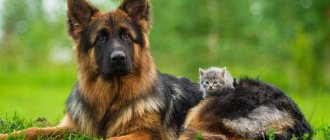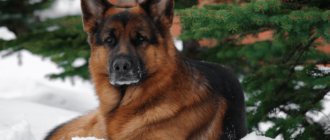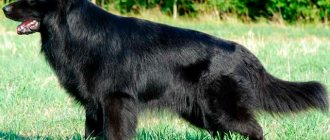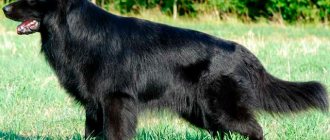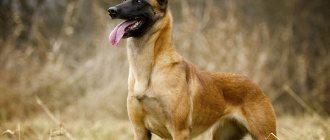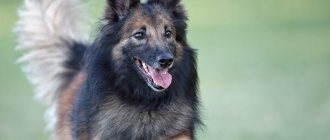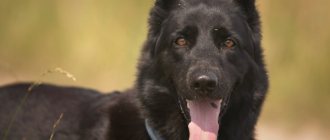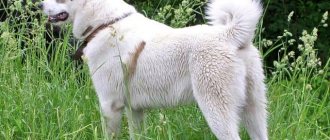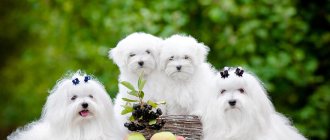The International Canine Organization has registered more than 400 dog breeds. Some weigh hundreds of grams, others - 80-90 kilograms. It’s difficult to remember and list everyone. But there are special dogs that, once seen, cannot be forgotten or confused with any other breed. For example, a beautiful, strong animal called the Mongolian Shepherd leaves a lasting impression on almost everyone.
Mongolian Shepherd
From the history of the breed
The exact origin of Mongolian Shepherds is unknown. But researchers suggest that the history of this breed goes back almost 15 thousand years. According to legend, in ancient times a mighty hunter came down from the mountains. He was accompanied by a huge dog, matching his owner, fierce and unsociable. She became the progenitor of modern bankhars. Dog handlers believe that the blood of Tibetan mastiffs and Great Danes flows in the veins of the modern Mongolian Shepherd Dog.
The breed developed naturally; selection did not affect it. In their homeland, dogs were used as guard and herding dogs. They can work at temperatures from minus 40 to plus 40 degrees, without fear of dust storms or snow whirlwinds. Banhar is a wolfhound, because domestic animals first of all had to be protected from predators.
It is known that since the 30s of the 20th century, bankhars began to be involved in security and investigative service in the NKVD. During World War II, the number of shepherd dogs declined sharply (as in many other breeds), they were on the verge of extinction. But since the 90s of the last century, enthusiasts have taken up their restoration. Now Banhars are bred in nurseries, and the situation in the breed looks much better, but they are still far from world fame and recognition.
The breed is not recognized by cynological organizations largely due to its small numbers. But in Mongolia, exhibitions are held where the exterior and performance qualities of bankhars are assessed.
Bankhars are starting to gain popularity outside of Mongolia
The winning shepherd dogs are awarded a handmade cup and medals in the form of the seal of Genghis Khan, which once again emphasizes the reverent attitude of the people towards these dogs.
Interesting Facts
There is a version that the Mongolian wolfhound took part in the raids of Genghis Khan himself and other famous conquerors. Huge dogs struck fear into people, and with their help the Mongols easily captured entire villages and cities.
At all times, bankhar khotosho (“hotosho” means house guard) helped people in hunting. The Mongolian bankhar helped the famous hunter Luvsan catch 22 thousand marmots, 9 hundred wolves, 2 hundred lynxes and almost a hundred bears.
During the Second World War, almost all representatives of this wonderful breed were exterminated. But in the 20th century, from the individuals that survived, they managed to restore the bankhar population in Mongolia.
Among the Buryats, the Mongolian bankhar is a respected animal; they are treated with respect. It is forbidden to offend such a dog.
In Mongolia, bankhar is not sold for money. It is believed that a sold animal grows up worthless. To get a Mongolian Shepherd puppy, you need to bring its owner a silk scarf or a piece of silk fabric.
Description of the breed
Since the Mongolian Shepherd has not received recognition from cynological organizations, it does not have an official breed standard. But there are still signs of what a real bankhar should look like, how to behave towards the owner and other people, what qualities it should have.
Table: features of the appearance of the Mongolian Shepherd
| Criterion | Description |
| Head | The skull is massive with a wide forehead. The muzzle is large, wide, and does not taper towards the nose. The transition from forehead to muzzle is smooth. The frontal groove is deep. The nose is triangular and large. |
| Eyes | Wide set, deep set. |
| Ears | Triangular in shape, hanging, covered with soft wool. Pressed tightly to the head. |
| Torso | Powerful with pronounced withers. The stomach is tucked. |
| Tail | Set on high. Covered with long hair. In a calm state it hangs like a log, in an excited state it is thrown over its back. |
| Limbs | Muscular and massive. The paws are very large and powerful. Long hair between toes. |
| Wool | Medium length - up to 10 cm. In the area of the withers, hips it is longer, forms a fluffy collar and pants. The down is thick and soft. |
| Color |
|
| Height |
|
| Weight | from 70 kg |
Bankhar can grow very large and weigh almost a hundredweight
general characteristics
extraordinary intelligence allows it to master a variety of “professions.” They make excellent guards, hunters, watchmen, rescuers, show dogs, pets, companions, and so on.
It is recommended to buy it for wealthy people living in the house. After all, the dog is not small, and even a large apartment will seem like a cramped cage to him. And given its significant size, it will require quite a bit of food, not counting medicines to maintain health and other things needed for maintenance. Having children or elderly people in the family is not a problem. The animal loves to play, so it often becomes a child's best friend. But it is important to explain to the child that the dog cannot be offended either by words or deeds. Proud and willful, she will not tolerate such treatment.
According to the standard, the minimum height of a male at the withers should be 60 cm , and that of a female – 55 cm . But usually they are much larger. The weight at the stage of formation of the animal should not be lower than 30 kg .
Character of Mongolian Shepherds
The character of the Banhars is phlegmatic, self-possessed, and non-conflicting. Unsociability and distrust of strangers are innate qualities.
Any stranger is perceived by Mongolian Shepherds with caution, but without aggression. Next, the dog evaluates the owner’s behavior towards the stranger and his own. Regardless of the conclusions the dog comes to, he will not immediately rush at a suspicious person, but he will show his attitude by growling, which can intensify if the stranger does not change his actions. When all warnings, in the opinion of the bankhar, have been exhausted, the wolfhound proceeds to decisive action. He rushes at the aggressor, knocks him to the ground and growls, lowering his muzzle to the enemy’s face, until the owner approaches.
Usually the menacing appearance and size of a shepherd dog is enough to understand that jokes with this dog can end badly.
Since ancient times, bankhars have been used to protect the herd, home and property of the owner. Most often, there is no need to teach them this; the qualities of a good watchman are passed on with mother’s milk.
Attitude towards other animals and children
Bankhars are loyal to other dogs because they work as a team. Showdowns can occur, especially between male dogs, so when raising a dog, close attention is paid to this aspect.
Bankhars can take patronage and patronage over their smaller brothers. Cats and rodents are not considered worthy of attention, but the shepherd dog will not tolerate familiarity from them either.
The Mongolian Shepherd gets along well with children, but will not become a nanny for them. In addition, children should not be left unattended near the bankhar. He may not only accidentally push the child, but also cannot tolerate the squeezing. The dog plays with pleasure with older children, because he is very active by nature.
The Mongolian wolfhound is immensely devoted to its family. He won’t show his feelings every minute, but he will definitely be affectionate when the opportunity arises.
Video: features of the Bankhar breed
Feeding
Banhar is unpretentious when it comes to food. You can feed both food and regular food. At the same time, meat and bones in the diet are not replaced by anything. Unless they feed the animal food. Just porridge, even with vitamins and vegetables, is not suitable for him. To raise a healthy, strong dog, it is important that the food is nutritious, healthy and balanced.
In each individual case, it is worth developing an individual diet taking into account the height, weight, age, physical characteristics, and health of the animal. Breeders and veterinarians will help with this.
How to choose a puppy
In the homeland of the Mongolian Shepherd, many traditions are associated with the choice of puppies. To this day they do this, guided by the knowledge received from the older generation, and even turn to shamans for help.
Puppies with a white spot on their chin are believed to bring good luck and wealth to their owner.
One way to test a dog's performance is to grab the puppy by the tail and lift it up. He must bend, but at the same time remain silent. They leave the whining and squirming baby - he will not make a reliable assistant. There is another ancient sign - they look into the puppy’s mouth, paying attention to the upper ribbed palate; there should be at least 9 stripes on it.
To a real dog handler, all these signs may seem funny, but the nomads themselves only use them.
It is customary to adopt a puppy at a very young age, approximately one month old. In order for him to grow into a good shepherd and guard, he is passed through a stirrup. If the puppy is older, he simply will not fit into it.
Price
Nomads do not sell their dogs - this is considered unacceptable, a bad omen. They can only be exchanged for some kind of gift, for example, a silk scarf.
Due to the growing popularity of the breed, private individuals are beginning to breed it. You can buy a puppy from them at a price of 6 thousand rubles, but this does not guarantee that the dog belongs to the Banhars. In nurseries, the cost of small shepherd dogs starts from 65 thousand, and the upper limit reaches 150 thousand rubles.
Since there is no strict breed standard, it is quite difficult to recognize a Bankhar puppy, so it is preferable to purchase from those breeders who can show the parents of the young.
Nicknames
Big, strong, beautiful and proud bankhar requires a special nickname. Most often they are chosen from foreign names or words that mean something. Suitable for a boy: Avchy, Adyl, Azhdarkha, Baland, Batyr, Vatan, Gurp, Davlat, Jannat, El, Zhaan, Ilkhan, Kaman, Nesher, Nuker, Sevmok, Talap, Tez, Ulug, Khal, Chikish, Shamol, El, Yakyn.
For a girl, you can choose a nickname from the following options: Alana, Galaba, Gez, Daldala, Zhandi, Zhaldyz, Kara Kelle, Mapa, Oila, Pata, Salashi, Fatiha, Khotin, Shoola, Erteki.
Keeping a Mongolian Shepherd
The Mongolian Shepherd is a freedom-loving dog. Working individuals spend the entire day in the wild, herding the herd or helping the owner in other ways. Nomads do not set up booths for them; bankhars themselves find a place to rest. These are ideal conditions for keeping this dog. An alternative can only be a private house with a spacious enclosure, but at the same time, the shepherd dog should still be out for a walk or at work most of the day.
The thick undercoat allows the bankhar not to be afraid of frost
Keeping a bankhar in an apartment will not have the best effect on his condition - physical and mental. Despite its rather large size, it is an energetic dog that needs a lot of space. It is also unclear why someone would decide to keep this pet in rooms. After all, he is not the best companion, and this dog’s character cannot be a piece of furniture.
Security qualities
The Mongolian Shepherd is gaining popularity in Russia. And here it turns into an exhibition toy, which has a passive - defensive reaction. In the Mongolian steppes, representatives of the breed are used to protect herds and human habitation from wolves. The emphasis is on security qualities. Puppies are selected according to this principle: if you pick up a baby by the tail or withers and he begins to bend, a good dog will grow up. If she hangs helplessly and whines, she is weak and cowardly, unfit for protection.
The Mongolian Shepherd warns strangers by growling, and if this is not enough, it knocks them off their feet and holds them until the owner arrives.
Features of care
The Mongolian Shepherd does not require any care that is different from other dogs. She needs:
- wipe your eyes daily;
- Clean your ears weekly with a soft cloth and inspect them for inflammation;
- comb at least once a week, and during the molting period - every other day.
Nomads, by tradition, do not fight tangles in the wool of bankhars; in ancient times, matted wool protected the dog from the teeth of the wolf
Only breeders groom bankhars. Nomads do not touch their fur, which is why it quickly becomes tangled on the collar and pants. This is not due to neglect of the dog, but according to tradition. When the dog entered into a fight with the wolf, he could not bite through the matted fur, so it acted as protection.
Your shepherd's teeth should be checked and cleaned once a week. But one should be accustomed to this procedure from childhood, otherwise the bankhar will regard this procedure as an encroachment on freedom. In any case, dental treats should be added to the diet, for example, special bones made from dry veins, which will mechanically clean the teeth of plaque.
The Mongolian Shepherd is fed twice a day. The basis of her diet should be meat. Boiled cereals and vegetables are added to it. Give fermented milk products and eggs no more than 2 times a week. It is completely acceptable to feed the bankhar with industrial products, but you will have to choose those that belong to the premium class and higher. Economy class food will not provide her with the necessary balance of nutrients, which will quickly affect the condition of the coat and motor activity.
The bankhar is fed at least 1 hour before work and immediately upon returning home. The veterinarian will help you calculate the portion size, but if the dog spends his day actively, then there is no need to be afraid that he will eat more than he should. You need to monitor your pet and feed based on its needs.
If a dog lives in a city, it can only be walked on a leash and with a muzzle.
Owner reviews
- Natalia, 36 years old, Novosibirsk
We moved to a private house, thought for a long time - who should we take, the choice fell on Banhar, because of his special character. It is ideal for keeping in our area and such a large family as mine (4 children) had to immediately give up natural food, it was too troublesome, the veterinarian recommended food, which he has had for 4 years now, the coat is in excellent condition, but more often is better It’s not good to comb your hair, it’s not good to walk around with tangles, after all, we don’t live in the forest. And the dog is not really very comfortable with them.
It tolerates low temperatures well, but we still prefer to take him indoors in severe frosts, and he is so happy that it’s hard to describe, but he still asks to go outside - my husband says he can’t leave his guard post.
She made it this year - a wool belt, gave it to her mother, now she asks for it for her friends, she says - problems with the lower back have practically disappeared. I really liked it. I love him - like 5 children, to be honest, although he eats like a foal.
Bankhar health
Many thousands of years of natural selection have awarded the bankhar with very good health. The dogs do not get sick with anything, and even hip dysplasia - the scourge of large breeds - has bypassed them. But breeders are required to vaccinate their dogs. It is advisable that the owner continue vaccination on schedule - some infections not only affect dogs, but are also dangerous to people (for example, rabies).
If your dog was not vaccinated as a child, you can start vaccination at any time. The veterinarian will develop an individual schedule that will need to be followed.
There is evidence that bankhars live up to 23 years. This only confirms the good health of these dogs.
Tragedy of the 20th century
Even before World War II, since 1932, bankhar served in the NKVD in Siberia. But already in 1937, he last took part in a service dog exhibition, where he won all the medals. Two years later, the government issues a decree on shooting the breed. The reason was a mistake by scientists. They believed that bankhar was a source of diseases dangerous to humans. Then they found out that this was not so, the dogs had already been destroyed.
Education and training
Like any large dog, the Bankhar needs training. But raising a puppy begins with its first steps in the owner’s house. The person must become an indisputable authority for the shepherd. You should consistently adhere to your requirements. Among nomads, young animals usually learn by looking at the behavior of older dogs, but if the puppy grows up alone, then it is better to go through a general training course with him.
If puppies grow up with adult dogs, they themselves master the wisdom of protection
Cruel methods of education are not used against bankhar. Physical violence fundamentally spoils the dog’s character: it becomes either cowardly or evil. In both cases, he will no longer be an assistant, and there will be no point in keeping such a dog. Therefore, the owner must be strict, but restrained and patient.
Wool
Banhar, whose photo can be seen in every canine reference book, has a luxurious fur coat. The fur of these animals is shiny, velvety, smooth, with a so-called “luster shine”. Its texture is something between fur seal and sable fur. The integumentary, or guard, hair is thin, but quite hard, straight and elastic.
The thick and dense undercoat is formed by downy hairs. The neck and shoulders are covered with thick fur, which forms a kind of mane. There are “pants” on the hind legs. On the rest of the body the fur is approximately the same length. Animals living in the southern Gobi regions have a coat length of 5-7 cm, while those living in the northern regions have a longer coat - 7-10 cm. Experts say that no breed of dog has a coat with this texture.
The main feature of bankhar wool is the absence of odor. This prevents the wolf from scenting the dog. But the most unique property of the breed is the absence of any smell at all. The shepherd always smells of the place in which it is located. This is an excellent disguise. Predators have no chance of noticing this dog's approach. They will only be able to smell it at a very close distance. Its smell is not accessible to the human sense of smell.
Eyes
The Mongolian bankhar has another distinctive feature. These are his amazing eyes. They are expressive, almond-shaped, usually brown in color, and set wide apart. The pupils are very small, since the vision of these animals is equally adapted to both very close and very far distances. When Bankhar Mongolian Shepherds look at the sun, their pupils turn into dots. In the dark, the eyes of these amazing dogs glow red. This color can also be seen in the daytime - when the bankhar threatens the enemy.
A distinctive feature of the color of this breed is the “spectacles” - light yellow rims around the eyes.
